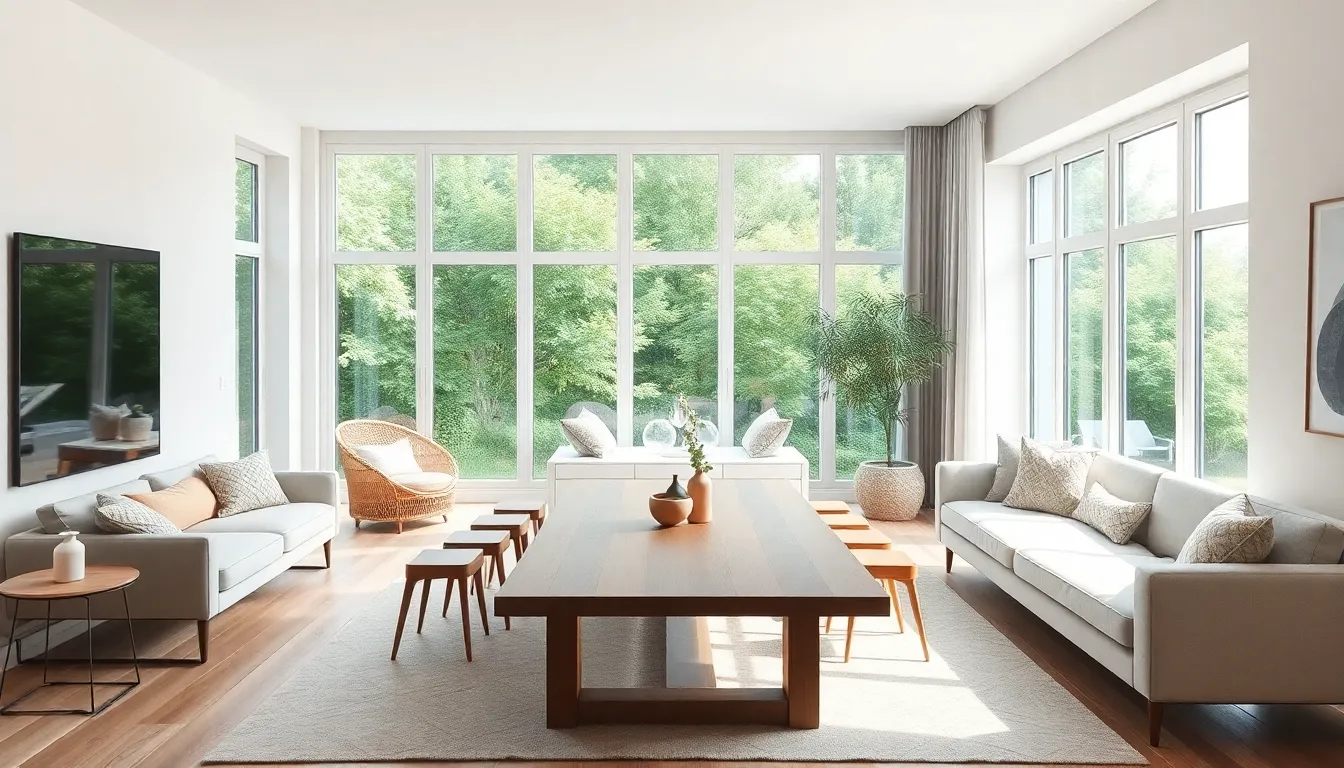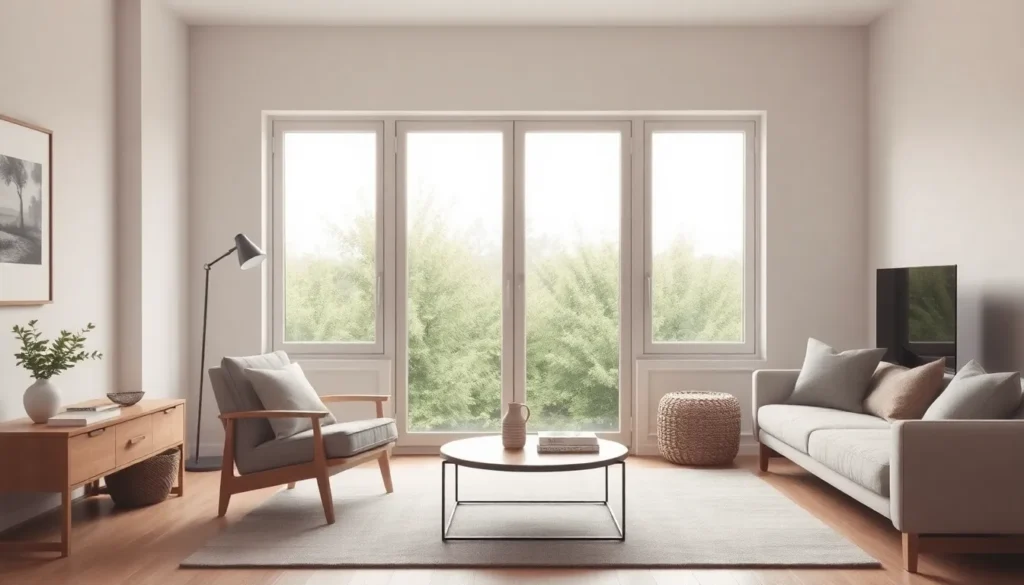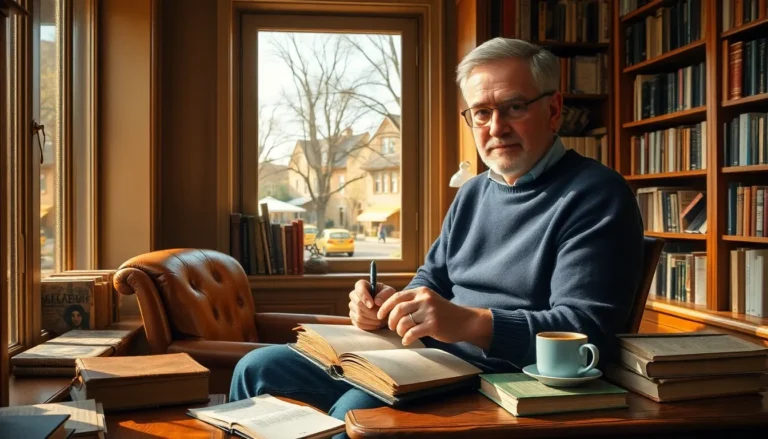Scandinavian design isn’t just a style; it’s a lifestyle that effortlessly combines form and function. Picture this: sleek lines, cozy textiles, and a color palette that whispers, “I’m calm and collected.” It’s like the minimalist version of a warm hug, inviting and stylish without the clutter.
Table of Contents
ToggleOverview of Scandinavian Design
Scandinavian design emphasizes simplicity, functionality, and elegance. This design approach originated in the Nordic countries, particularly Denmark, Sweden, Norway, Finland, and Iceland. It stands out for its focus on clean lines and minimal ornamentation, highlighting the beauty of natural materials. Wood, leather, and textiles play significant roles in creating warm and inviting spaces.
Functionality remains a core principle of Scandinavian design. Furniture and home accessories are often designed with practical use in mind, ensuring that every piece serves a purpose. The adaptability of these designs allows them to suit various living environments, from small urban apartments to spacious rural homes.
Color palettes draw inspiration from the natural landscape. Soft, muted tones dominate the aesthetic, featuring whites, grays, and gentle pastels. These colors promote a sense of calmness and serenity, contrasting with darker, more vibrant tones.
Sustainability is increasingly important in Scandinavian design. Many designers prioritize eco-friendly materials and production methods, reflecting an awareness of environmental impact. This commitment goes beyond aesthetics, promoting a lifestyle rooted in conscientious consumption.
Innovation and tradition coexist within this design philosophy. Traditional craftsmanship meets modern technology, resulting in unique creations that honor heritage while embracing contemporary style. Iconic designers such as Alvar Aalto and Arne Jacobsen epitomize this blend of influences.
Overall, Scandinavian design offers a harmonious framework that combines beauty with functionality. Its principles encourage a lifestyle that values simplicity, quality, and well-being in everyday living spaces.
Key Characteristics of Scandinavian Design

Scandinavian design embodies a unique blend of aesthetics and practicality. It prioritizes efficiency and beauty through distinct characteristics.
Minimalism
Minimalism defines Scandinavian design by fostering simplicity in form and function. Clean lines dominate the aesthetic, enhancing visual appeal without unnecessary clutter. Every piece serves a purpose, reflecting the “less is more” philosophy. Spaces often feature open layouts that encourage light and air circulation. Essential items exhibit elegance while remaining unpretentious. This approach creates a calming environment ideal for relaxation and productivity.
Functionality
Functionality represents a cornerstone of Scandinavian design principles. Each item, whether furniture or accessory, emphasizes practical use. Designers create versatile pieces that adapt to various living situations, maximizing space efficiency. Multi-functional furniture, such as convertible sofas or extendable tables, showcases this emphasis on versatility. An underlying focus on ergonomics ensures comfort alongside practicality, enhancing everyday experiences. This commitment to usability reflects a deep understanding of modern lifestyles.
Nature-Inspired Elements
Nature-inspired elements play a significant role in Scandinavian design. Designers draw from the natural landscape, incorporating organic shapes and materials. Wood, leather, and textiles feature prominently, connecting interiors to the outdoors. Soft, muted color palettes mirror the scenic beauty of Nordic environments, promoting serenity. Large windows facilitate natural light, blurring the boundary between indoor and outdoor spaces. This connection to nature fosters a harmonious atmosphere, resonating with well-being and sustainability.
Historical Background
Scandinavian design reflects the rich cultural history of the Nordic countries, setting a foundation for contemporary aesthetics.
Origins and Influences
Scandinavian design originated in the early 20th century, influenced by functionalism and the Bauhaus movement. Designers sought to create accessible and practical furniture, prioritizing simplicity and utility. The early modernist ideals drew inspiration from nature, emphasizing natural materials like wood. Viking traditions also played a role, showcasing craftsmanship and a connection to the environment. These roots forged a unique aesthetic that resonated with the values of Nordic lifestyles, promoting comfort and functionality.
Evolution Through the Decades
Over the decades, Scandinavian design evolved into a globally recognized style. The post-World War II era saw a surge in popularity, as affordable yet stylish furniture gained attention. Iconic designers like Hans Wegner and Greta Grossman contributed to the movement, emphasizing minimalist forms and multi-functional pieces. The 1960s and 1970s introduced bold colors and patterns, enhancing visual appeal while retaining core principles. Today, contemporary Scandinavian design combines innovative technology with sustainable practices, ensuring continued relevance and environmental consciousness.
Iconic Scandinavian Designers
Scandinavian design boasts several iconic designers who shaped the movement. Their contributions highlight functionality, simplicity, and natural materials.
Hans Wegner
Hans Wegner exemplifies craftsmanship and innovation. Known for his classic chair designs, Wegner created over 500 chairs, including the iconic Wishbone chair, combining elegance and comfort. His work emphasizes organic shapes, making furniture that fits the human form. Inspiration from traditional Danish craftsmanship drives his creations, showcasing quality and durability. Wegner’s designs gained recognition for their timeless appeal, influencing both modern and contemporary furniture design. He championed the philosophy that furniture enhances daily living, enabling spaces to feel more inviting.
Alvar Aalto
Alvar Aalto is celebrated for merging architecture and furniture design. His love for nature inspired iconic pieces like the Paimio chair, which showcases flowing lines and organic forms. Aalto’s work emphasizes functionality along with aesthetics, aiming for harmony in living spaces. He pioneered the use of bent plywood, proving that natural materials create warmth and comfort. His innovative spirit led to a distinctive style that combines modernism with a human touch. Aalto’s legacy includes numerous buildings, like the Villa Mairea, reflecting his commitment to creating welcoming environments.
Arne Jacobsen
Arne Jacobsen stands out for his holistic design approach, integrating architecture with furniture. His Egg and Swan chairs exemplify sculptural aesthetic while prioritizing comfort and functionality. Jacobsen believed that design should cater to user experience, resulting in intuitive shapes that suit diverse environments. His work showcases clean lines and minimalist forms, consistent with Scandinavian design principles. Jacobsen’s influence extends beyond furniture, impacting architecture worldwide through iconic buildings like the SAS Royal Hotel in Copenhagen. His designs remain relevant, continuing to resonate in contemporary design contexts.
Contemporary Trends in Scandinavian Design
Contemporary Scandinavian design embodies sustainability and technology. By focusing on these areas, designers create spaces that are both beautiful and functional.
Sustainable Practices
Sustainable practices serve as a cornerstone of Scandinavian design. Designers prioritize eco-friendly materials, such as reclaimed wood and organic textiles, which minimize environmental impact. Brands often adopt transparent production processes that promote ethical sourcing. Recycling and reusing materials also enhance waste reduction efforts, aligning with core values of nature respect. The influence of sustainability extends beyond aesthetics; it shapes lifestyles that advocate for conscientious consumption and environmental stewardship.
Technology Integration
Technology integration enhances the appeal of Scandinavian design. Smart home devices get seamlessly incorporated into interior spaces, creating convenience without sacrificing style. Designers often embrace innovations that improve energy efficiency and user experience, like smart lighting and climate control systems. Furniture is also being reimagined to include charging stations and built-in tech solutions, merging functionality with contemporary needs. The push for modern solutions ensures Scandinavian design remains relevant in an ever-evolving environment.
Scandinavian design represents a unique blend of aesthetics and functionality that resonates deeply with modern living. Its commitment to simplicity and sustainability not only enhances interior spaces but also promotes a mindful lifestyle. By prioritizing natural materials and eco-friendly practices, it fosters a connection between people and their environments.
As this design philosophy continues to evolve, it remains a powerful influence on contemporary decor. The legacy of iconic designers ensures that Scandinavian design will inspire future generations to embrace a harmonious balance of beauty and practicality. Ultimately, it encourages everyone to create spaces that reflect their values while enhancing their well-being.



